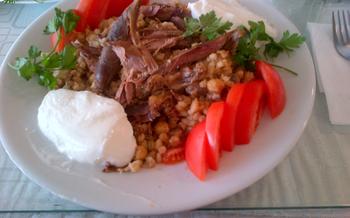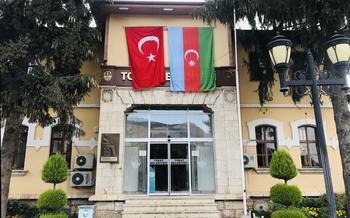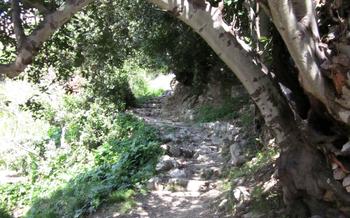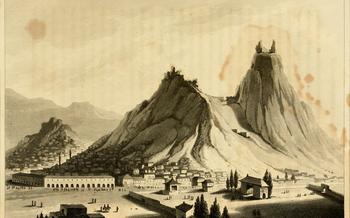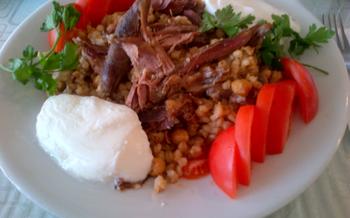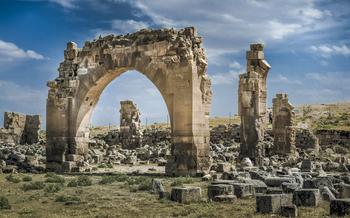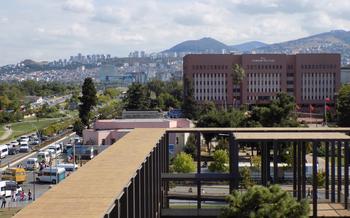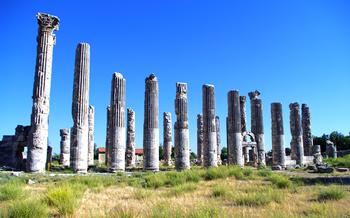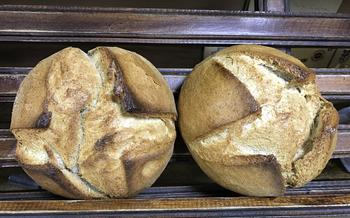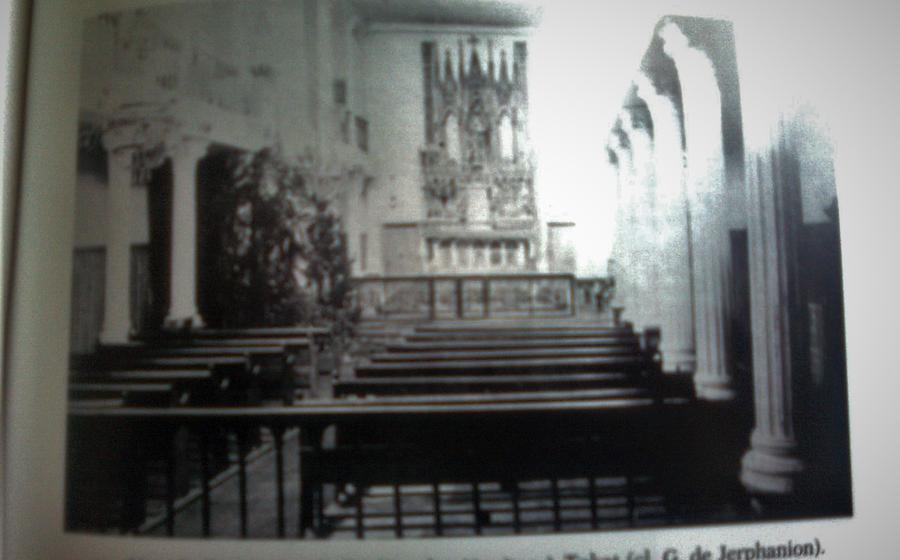
Kazova (Dazimon) Ancient City
- History of Kazova (Dazimon) Ancient City
- Location and Accessibility
- Key Features and Structures
- Historical Significance and Cultural Value
- Excavations and Archaeological Discoveries: Unraveling the Past of Kazova (Dazimon)
- Museums and Exhibitions
- Nearby Attractions and Activities
- Best Time to Visit
- Practical Tips for Visitors
- Guided Tours and Local Experts
- Accessibility for Differently-Abled Visitors
- Insider Tip: Unveiling the Hidden Sanctuary
History of Kazova (Dazimon) Ancient City
In the heart of Turkey's Tokat province lies the ancient city of Kazova, known as Dazimon in ancient times. Its history stretches back to the Hellenistic period, when it emerged as a significant cultural and commercial center. Founded by the Oğuz Turks in the 11th century, it flourished under their rule and became a bustling hub of activity. However, with the Mongol invasion in the 13th century, the city faced decline and was eventually abandoned. Archaeological excavations have unearthed remnants of its glorious past, revealing the grandeur of its architecture, the vibrancy of its marketplace, and the significance of its religious structures, offering a glimpse into the rich tapestry of ancient Anatolian civilization.
Location and Accessibility
Kazova (Dazimon) Ancient City is situated in the Niksar district of Tokat province, Turkey. To reach the site, visitors can take the scenic Tokat-Niksar road, which offers breathtaking views of the surrounding countryside. Once in Niksar, follow the signs or ask locals for directions to Kazova village. From the village, a short walk or drive leads to the ancient city's entrance.
Public transportation options are limited, but visitors can take a bus from Tokat to Niksar and then transfer to a local minibus or taxi to reach Kazova village. Renting a car offers more flexibility and allows for exploring other nearby attractions at your own pace.
Kazova (Dazimon) Ancient City is conveniently located near several other popular tourist destinations in Tokat. The city of Tokat itself boasts a rich history and cultural heritage, with landmarks such as the Tokat Castle, the Great Mosque, and the Tokat Museum. The surrounding area also offers natural wonders like the Ballıca Cave and the Yeşilırmak River, providing opportunities for hiking, camping, and other outdoor activities.
Key Features and Structures
The ruins of Kazova (Dazimon) Ancient City reveal a remarkable array of well-preserved structures that offer a glimpse into the city's grandeur. The Acropolis, perched atop a hill, stands as a testament to the city's defensive prowess, with its sturdy fortifications and commanding views of the surrounding landscape.
At the heart of the ancient city lies the Agora, once a bustling marketplace where traders from near and far converged to conduct business. The Agora's spacious courtyard, lined with shops and stalls, echoes with the sounds of haggling and the clinking of coins.
Among the most impressive structures is the Temple of Zeus, a testament to the city's religious beliefs and practices. Dedicated to the king of the gods, the temple's imposing facade and intricate carvings speak to the skill and devotion of its ancient builders.
Other notable buildings within the city include the theater, where dramas and performances once entertained the masses, and the gymnasium, where athletes honed their skills and competed for glory. The public baths, with their elaborate mosaics and heated pools, offer a glimpse into the daily lives and leisure pursuits of Kazova's inhabitants.
Exploring these ruins is like stepping back in time, allowing visitors to imagine the vibrant life that once filled the streets of this ancient city.
Historical Significance and Cultural Value
Kazova (Dazimon) Ancient City played a pivotal role in the development of Anatolian civilization and culture. As a center of learning, philosophy, and the arts, it attracted scholars, philosophers, and artists from across the region. Its contributions to various fields, including architecture, literature, and science, left a lasting impact on the cultural landscape of antiquity.
The city's strategic location at the crossroads of trade routes made it a melting pot of diverse ethnicities and cultures. Merchants, travelers, and pilgrims from different parts of the ancient world converged in Kazova (Dazimon), fostering cultural exchange and mutual enrichment. This cosmopolitan atmosphere contributed to the city's vibrant intellectual and artistic scene.
The enduring legacy of Kazova (Dazimon) Ancient City is evident in its lasting influence on modern Turkish culture. Many of the city's architectural features, decorative motifs, and artistic traditions can be traced back to its ancient roots. The city's rich history and cultural heritage continue to inspire contemporary Turkish artists, writers, and musicians, ensuring that the spirit of Kazova (Dazimon) lives on through the ages.
Excavations and Archaeological Discoveries: Unraveling the Past of Kazova (Dazimon)
Over the decades, archaeological excavations at Kazova (Dazimon) Ancient City have yielded a treasure trove of discoveries, shedding light on the city's rich past and daily life. Excavations conducted by teams of archaeologists have uncovered impressive artifacts, inscriptions, and architectural remains that provide valuable insights into the city's history and culture.
Significant discoveries include well-preserved mosaics depicting intricate scenes from mythology, pottery fragments with inscriptions that offer glimpses into the city's administration and trade, and coins that reveal the economic activities and monetary systems of the time. Furthermore, the excavation of residential areas has unearthed domestic objects, such as cooking utensils and storage jars, providing a glimpse into the everyday lives of Kazova's inhabitants.
These archaeological findings have played a crucial role in piecing together the puzzle of Kazova's (Dazimon) history. They have helped researchers understand the city's urban planning, architectural styles, and cultural practices, contributing to a better understanding of the development of Anatolian civilization. Ongoing excavations continue to uncover new artifacts and information, promising even more revelations about this ancient city's fascinating past.
Museums and Exhibitions
Within the vicinity of Kazova (Dazimon) Ancient City, there are several museums and exhibition spaces that offer a deeper dive into the history and culture of the site. The Tokat Museum houses a collection of artifacts unearthed during excavations at the ancient city, including pottery, coins, sculptures, and inscriptions. These artifacts provide valuable insights into the daily life, customs, and artistic traditions of Kazova's inhabitants.
Visitors can also explore the Kazova Archaeological Museum, located near the ancient city. This museum showcases a range of archaeological finds, including architectural fragments, tools, and jewelry, that further illuminate the city's rich past. Through interactive displays and informative panels, these museums provide a comprehensive overview of Kazova's significance and its contributions to ancient Anatolian civilization.
Admission fees to these museums are typically affordable, and guided tours are available in multiple languages. Whether you're a history buff, an archaeology enthusiast, or simply curious about the ancient world, these museums offer a rewarding opportunity to delve deeper into the captivating story of Kazova (Dazimon) Ancient City.
Nearby Attractions and Activities
Apart from immersing yourself in the ancient history of Kazova (Dazimon), there's a wealth of nearby attractions and activities that will further enrich your exploration of Tokat. Here are a few suggestions to enhance your itinerary:
-
Sulusaray: Only a stone's throw away from Kazova (Dazimon), Sulusaray offers a refreshing respite with its picturesque waterfalls and lush greenery. Take a leisurely stroll along the cascading waters, soak in the tranquil ambiance, and capture some stunning photographs of this natural wonder.
-
Tokat Kalesi (Tokat Castle): Perched atop a hill overlooking the city, Tokat Kalesi is a majestic fortress with a rich history dating back to the Byzantine era. Explore its imposing walls, admire the architectural details, and revel in the panoramic views of Tokat and the surrounding landscapes.
-
Gölbaşı National Park: Escape the urban hustle and bustle and immerse yourself in the tranquil beauty of Gölbaşı National Park. This sprawling park is home to a pristine lake, lush forests, and diverse wildlife. Whether you prefer hiking amidst nature, enjoying a picnic by the lake, or simply relaxing in the serene surroundings, Gölbaşı offers a rejuvenating experience for all.
-
Tokat Museum: Delve deeper into the region's cultural heritage at the Tokat Museum. This well-curated museum houses an impressive collection of artifacts, including archaeological finds from Kazova (Dazimon) and other historical sites in Tokat. Discover intricate pottery, ancient tools, and fascinating exhibits that shed light on the rich past of this Anatolian province.
-
Local Villages and Crafts: Take a break from historical exploration and venture into the charming villages surrounding Tokat. Each village has its own unique character and traditions. Whether it's witnessing traditional crafts like carpet weaving or savoring local delicacies, immersing yourself in the authentic village life offers a glimpse into the heart and soul of Anatolian culture.
Best Time to Visit
Kazova (Dazimon) Ancient City welcomes visitors throughout the year, but the choice of the best time to visit depends on individual preferences and priorities.
-
Spring (April-May): Spring offers pleasant weather with moderate temperatures, making it ideal for exploring the ancient ruins without the summer heat. Visitors can enjoy the beauty of wildflowers blooming amidst the historical structures.
-
Summer (June-August): While the summer months bring hot and dry weather, they also offer longer daylight hours, allowing for extended exploration of the site. This time is suitable for those who enjoy warm weather and don't mind the crowds that tend to increase during the peak tourist season.
-
Autumn (September-October): Autumn is an excellent time to visit Kazova (Dazimon) Ancient City as the weather remains warm and comfortable, with fewer crowds compared to the summer months. The changing colors of the surrounding landscape add a picturesque charm to the ancient ruins.
-
Winter (November-March): Winter transforms the ancient city into a serene and tranquil place, with occasional snowfall creating a magical atmosphere. However, it's important to note that some areas of the site may be inaccessible due to snow and ice, and visitors should come prepared for cold weather.
Regardless of the time of year, visitors to Kazova (Dazimon) Ancient City should pack comfortable walking shoes, sun protection, and plenty of water, especially during the hotter months.
Practical Tips for Visitors
Essential information for a successful visit to Kazova (Dazimon) Ancient City:
-
Clothing and Footwear: Dress comfortably and appropriately for the weather conditions. Wear sturdy, comfortable shoes suitable for walking on uneven surfaces.
-
Sun Protection: The sun can be intense, especially during the summer months. Bring a hat, sunglasses, and sunscreen to protect yourself from the sun's harmful rays.
-
Facilities: There are limited facilities available within the ancient city. Bring your own water and snacks, as there are no shops or restaurants on-site. Restrooms are also limited, so plan accordingly.
-
Respect the Ruins: Remember that you are visiting a historical site. Be respectful of the ruins and avoid touching or climbing on them.
-
Tread Lightly: The ancient city is a fragile ecosystem. Stay on designated paths and avoid stepping on plants or disturbing the wildlife.
Guided Tours and Local Experts
Exploring Kazova (Dazimon) Ancient City with a knowledgeable guide can significantly enrich your experience. Guided tours offer a deeper understanding of the site's history, cultural significance, and architectural features. Local historians, archaeologists, or experienced tour guides can provide insights into the daily lives of the ancient inhabitants, the city's role in regional trade, and the stories behind the ruins.
Guided tours are available in various languages and can be booked in advance or arranged on-site. The duration of the tours varies, typically ranging from one to three hours, depending on the level of detail and the specific interests of the group. The cost of the tours is generally affordable and includes the services of the guide.
The expertise of local guides is invaluable in bringing the ancient city to life. They can point out hidden details, explain the significance of architectural elements, and share anecdotes that bring the past closer. Their knowledge and passion for history can transform a visit to Kazova (Dazimon) into a truly immersive and memorable experience.
Accessibility for Differently-Abled Visitors
Kazova (Dazimon) Ancient City recognizes the importance of accessibility and strives to ensure that visitors of all abilities can enjoy the wonders of the ancient past. Accessible features have been implemented to accommodate differently-abled visitors and make their exploration as comfortable and fulfilling as possible.
Ramps and designated parking spaces are available to facilitate easy access to the site. Once inside, accessible pathways guide visitors through the ancient ruins, allowing them to immerse themselves in the city's rich history without barriers.
For those with mobility challenges, wheelchairs can be rented at the entrance to the site, ensuring that everyone has the opportunity to explore the ancient city's wonders. Additionally, trained staff is always ready to assist visitors with specific needs, providing information and guidance to enhance their experience.
Kazova (Dazimon) Ancient City is committed to inclusivity and believes that everyone should have the chance to connect with the past. By offering accessible features and services, the city ensures that all visitors can create lasting memories and gain a deeper appreciation for the rich cultural heritage that lies within its ancient walls.
Insider Tip: Unveiling the Hidden Sanctuary
Venture beyond the main ruins of Kazova (Dazimon) Ancient City and discover a hidden sanctuary that exudes tranquility and mystery. Nestled amidst the ancient olive groves, this secluded spot offers a unique perspective on the city's rich history.
To find this hidden gem, follow the winding path that leads away from the bustling Agora. As you traverse the gentle slopes, keep an eye out for a cluster of ancient stones, partially hidden by the lush vegetation. These stones mark the entrance to the sanctuary.
Step inside and be transported to a realm of serenity. The sanctuary comprises a small temple dedicated to a forgotten deity, its walls adorned with intricate carvings that depict scenes from ancient myths and legends. The air is still and silent, as if time itself has paused within these sacred grounds.
Take a moment to sit on one of the stone benches and soak in the atmosphere. Let your imagination wander as you envision the rituals and ceremonies that once took place here. Feel the energy of the ancients as you connect with the spiritual essence of this hidden sanctuary.
Remember to tread lightly and respect the sanctity of this special place. Leave no trace of your visit, allowing future generations to discover the magic of this hidden gem.
